.
.
.
…..Jazz in Available Light, Illuminating the Jazz Greats from the 1960s, ’70s, and ’80s is one of the most impressive jazz photo books to be published in a long time. Featuring the brilliant photography of Veryl Oakland — much of which has never been published — it is also loaded with his often remarkable and always entertaining stories of his experience with his subjects.
…..With the gracious consent of Mr. Oakland — an active photojournalist who devoted nearly thirty years in search of the great jazz musicians — Jerry Jazz Musician regularly publishes a series of posts featuring excerpts of the photography and stories/captions found in this important book.
In this edition, Mr. Oakland’s photographs and stories feature drummers Jo Buddy Rich, Louie Bellson/Tony Williams and Shelly Manne in “A Succession of Battery Mates, Part 2”
.
.
.
All photographs copyright Veryl Oakland. All text excerpted from Jazz in Available Light, Illuminating the Jazz Greats from the 1960s, ’70s, and ’80s
.
You can read Mr. Oakland’s introduction to this series by clicking here
.
.
_____
.
.
A Succession of Battery Mates (Part Two)
.
.
© Veryl Oakland

.
The Showman, Personified
Buddy Rich
Monterey, California
.
…..At the time, I didn’t know he was the man who played the “Lone Ranger” theme on popular radio broadcasts that I listened to every week. What I do remember was his visit to Sioux Falls, (SD), and his featured performance with our Washington Senior High School Band.
…..According to my band instructor, “America’s Premier Cornet Soloist” Leonard B. Smith was the one I should try to emulate as I continued to improve as a young fledgling on the same instrument. I remember how technically perfect he sounded that night playing, “Carnival of Venice,” to a packed auditorium. Some time afterwards, the school also invited the flamboyant trumpeter Rafael Mendez as guest soloist. When he played “The Flight of the Bumble Bee,” I was amazed.
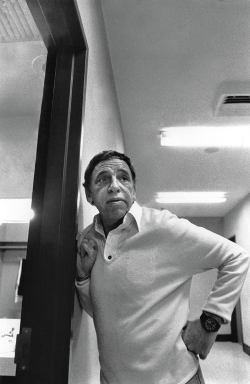
…..Notwithstanding the excellence that each of these brassmen exhibited, it was a live big band performance several months later that really got my juices flowing.
…..In the mid-1950s, my parents took me to the Corn Palace in Mitchell, an hour’s drive away, to see the Harry James Orchestra. As expected, the band swung hard and the trumpet virtuoso drew standing ovations for his spectacular solos.
…..But it was the human dynamo surrounded by all the percussion equipment who practically stole the show that day. That was the first time I heard the name, Buddy Rich.

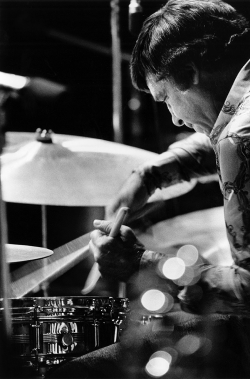
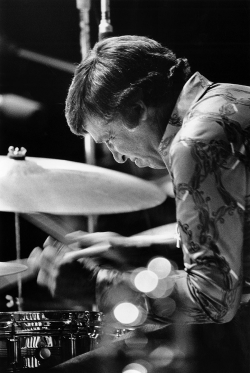
…..I got to know the flamboyant drummer after he had formed his own big band. By 1969, Rich had become a regular fixture on the festival circuit, and I began crossing paths with him frequently. For many, he was the main draw for any big night of entertainment. He easily qualified as one of jazz’s greatest technicians, yet didn’t overshadow his young corps of disciplined, swinging players. He was also his own best promoter, becoming the unpredictable, semi-regular foil on such popular programs as The Tonight Show with Johnny Carson.
…..Some found the man to be caustic and condescending. But I always saw Buddy’s mannerisms as his way of simply staying loose. His schtick, just as you saw him on TV, was to purposefully fluster, and play games with his questioners, constantly keeping them off-guard. He was without doubt a most serious musician, but he certainly didn’t take himself seriously.
…..Maybe it was only because I was carrying cameras every time he saw me, but I always found Buddy to be open and engaging, pleasing to be around. In one of our earlier meetings, I shared my story about seeing him for the first time as a high-schooler. He appeared to have gotten a kick out of that. Whatever discussions we had were playful, mostly amounting to small talk. Over the years, he seemed to welcome my occasional intrusions of his space, and was always responsive to a particular photo request.
…..Catching Buddy Rich in performance was always a major event. I was reminded of just how prescient the jazz writer and critic Whitney Balliett was when he described one of Buddy’s concerts for his book, Collected Works: A Journal of Jazz, 1954-2000. He wrote, “(Rich)… punctuated breaks and shaded melodic passages and underlined crescendos with such pinpointed verve that the musicians were nearly lifted out of their seats, and then he took a breathtaking solo. It had dynamics, unbelievable speed, and a whirling inventiveness. It was a mad, magnificent performance.”
…..Similarly, while covering the drummer and his band during the 1972 Monterey Jazz Festival, I captured an instant that might serve as an exclamation mark to what the critic had offered in his book. Near the conclusion of his set, after completing a wickedly-sustained, white-hot drum solo, Buddy Rich reacted to his pulsing nerves by grabbing his chops as the crowd roared in unison.
.
© Veryl Oakland
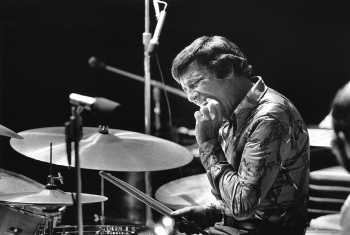
Bernard (Buddy) Rich – drums, leader, singer
Born: September 30, 1917
Died: April 2, 1987
.
.
Watch Buddy Rich play the drums!
.
.
.
.
_____
.
.
© Veryl Oakland
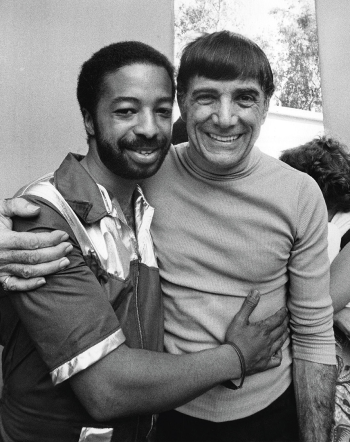
.
Mutual Admiration
Louie Bellson & Tony Williams
Berkeley, California
.
…
…..From a distance, it appeared to be a chance encounter: there, just off-stage at the 1978 Berkeley Jazz Festival, stood the wise sage and the young buck sharing a warm embrace.
…..Of course, both were drummers, so it wasn’t exactly a revelation. After all, battery mates of every stripe have lots in common. But for any casual observer looking on, Louie Bellson and Tony Williams – born practically a generation apart – were seemingly about as mismatched as two percussionists could be.
…..It was only natural that their influences, tastes, and actual performance artistry would be dissimilar. Bellson made his bones solidly backing some of the most popular big bands of the swing era, particularly the Duke Ellington Orchestra, which adhered to the written scores. Williams, who represented the changing free/fusion period of jazz music styles, was the powerhouse teenage upstart hand-picked by Miles Davis for his second great quintet from the mid-1960s.
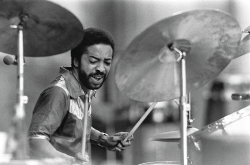
.
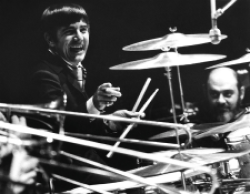
…..The longer I stood there watching, I realized there was nothing accidental about this meeting. The two continued to carry on a purposeful dialogue, thoughtfully engaging one another. Here were a couple of really close friends getting together once again to talk shop and share meaningful times.
…..Instead of concentrating on their differences, I began to think of the many attributes that made these artists such close musical soulmates: the pair, uniquely blessed with astonishing technique, shared the commonality of perfect time; both were astute listeners who always complemented their respective band members; and perhaps most importantly, the duo took special pride in being complete musicians, highly regarded for their considerable skills as serious composers and arrangers. Their respective leaders paid them the highest compliment by frequently playing, and recording, their works.
…..It was some time later, after reading his book, Louie Bellson Honors 12 Super Drummers: Their Time Was the Greatest, that I discovered just how strong of a bond existed between these two craftsmen. Bellson, who had helped revitalize the Ellington band in 1951 by prominently being featured center stage as the first percussionist to use two bass drums in his setup, talked about one of his initial encounters with the youngster.
…..Because Tony recognized that many other drummers – both in jazz, as well as in rock bands – were suddenly following in Bellson’s footsteps, he remarked, “I’m getting two bass drums.”
…..Louie, who considered Williams a natural player and a true original, told Tony, “Don’t do it. You don’t need it.”
…..The elder time-keeper, who was a keen observer of new talent arriving on the scene, assured Tony that his playing style was unique and didn’t require any equipment tampering. He was quick to rave about Williams being one of his personal favorites of all time. “Tony Williams gave us all a new approach to the drum set – a stylist who can swing hard and solo with great imagination.”
.
© Veryl Oakland
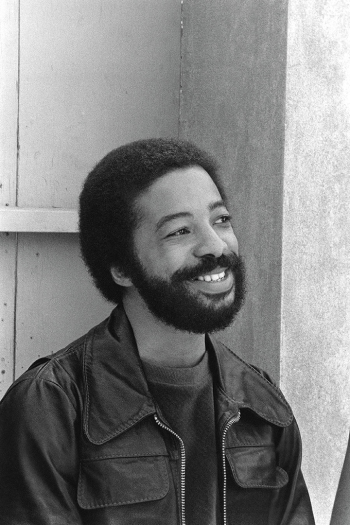
.
Tillmon Anthony (Tony) Williams – drums, composer
Born: December 12, 1945
Died: February 23, 1997
.
© Veryl Oakland
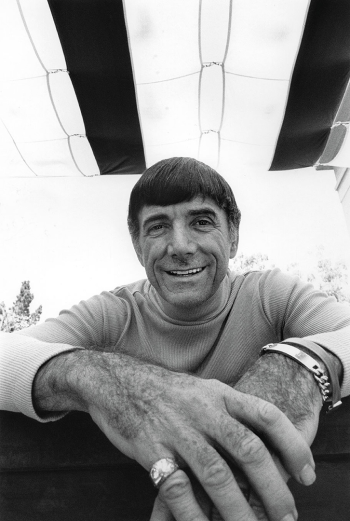
.
Louie Paul Bellson (Luigi Paulino Alfredo Francesco Antonio Balassoni) – drums, composer, leader, educator
Born: July 6, 1924
Died: February 14, 2009
.
.
Watch a 1967 film of Tony Williams play the drums (with Miles Davis)
.
.
Watch a 1967 film of Louie Bellson playing “Bellson Blues”
.
.
.
.
_____
.
.
.
.
© Veryl Oakland
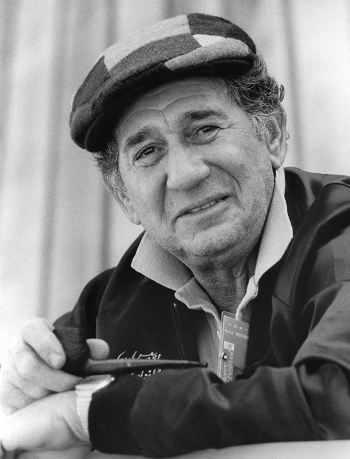
.
Honoring a True Elite
Shelly Manne
Monterey, California
.
…..The last time I photographed him was late on a Sunday, the final day of the 1984 Monterey Jazz Festival. He was relaxing on the grounds behind the main stage, appearing just as mellow, easygoing, and fit as always. I approached him and said, “Shelly, we should do some informal candids…you’re looking better than ever.”
…..Because we had crossed paths so many times over the previous 15 years, it only seemed natural that my meetings with the drummer who symbolized West Coast Jazz would continue for many more years to come. Three days later, after returning home to Los Angeles, Shelly Manne died of a massive heart attack.
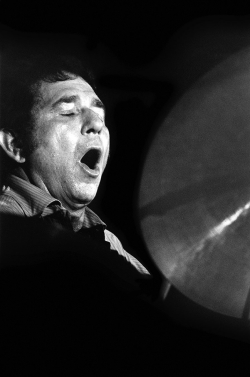
…..Most everywhere the drummer appeared, it was his name that usually received top billing: “Shelly Manne and His Men.” And true to form, whenever I caught him in performance, whether guiding a huge studio orchestra or providing the delicate touch to a smooth quartet, he struck me as the consummate leader.
…..He was internationally celebrated as one of the prime movers of the established cool style of modern music that sharply contrasted with the driving bebop, and later, hard bop styles preferred back east. And because he stood apart from so many of his peers stylistically, some gave him a bad rap. Certain critics insinuated that Shelly Manne couldn’t be considered a serious jazz musician if many of his music business credits included dominating the Hollywood motion picture and TV film scores.
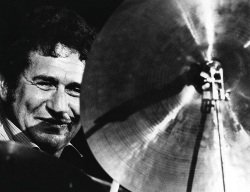
…..I believe he was so much more. To my mind, Shelly Manne was the epitome of the melodic drummer, and perhaps as comfortable as any of jazz’s recognized greats in virtually all musical settings. He was subtle, not showy. No matter the group, you could not miss his versatility – he could bring whatever beat, whatever exceptional sound necessary, to make the performance eventful.
…..I remember that August night when the original “LA Four” members (guitarist Laurindo Almeida, saxophonist-flutist Bud Shank, bassist Ray Brown, and Shelly Manne) appeared at the 1974 Concord Summer Festival. Their live recording date, LA Four Scores!, was that group’s debut offering, featuring some bossa nova and classical-oriented compositions by Almeida.
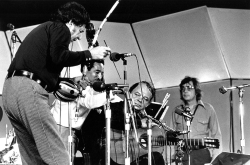
…..On one of those numbers, “Berimbau Carioca,” Shelly retrieved a berimbau from his drum kit, a strange-looking, Brazilian-made wooden single-string bow attached to a gourd. Despite his tongue-in-cheek comment to the audience about the berimbau’s many uses – “You can hunt with it, or you can smoke it…” – Shelly’s deft pecking and tapping on the string perfectly embellished the sprightly interchange between Shank on flute and Almeida. Appreciating the warm summer breezes that evening, It was almost as if we were being transported to the sandy shores of Bahia.
…..For those who continue to trivialize the drummer or try to lessen his impact in the jazz world, I find myself in the opposite camp. Had he remained in New York, the home of his birth, who’s to say that Shelly Manne wouldn’t have been ranked right up there with the recognized East Coast elites, led by such drummers as Max Roach, Roy Haynes, Art Blakey, Philly Joe Jones, and Elvin Jones?
.
.
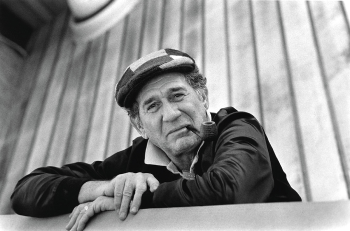
Sheldon (Shelly) Manne – drums, leader, composer
Born: June 11, 1920
Died: September 26, 1984
.
.
Watch a 1962 film of Shelly Manne and His Men (Conte Candoli, Richie Kamuca, Russ Freeman and Monty Budwig) play “Speak Low”
,
.
.
_____
.
.
.
Click here to read the edition featuring Stan Getz, Sun Ra and Carla Bley
Click here to read the edition featuring Art Pepper, Pat Martino and Joe Williams
Click here to read the edition featuring Yusef Lateef and Chet Baker
Click here to read the edition featuring Mal Waldron, Jackie McLean and Joe Henderson
Click here to read the edition featuring Dexter Gordon, Art Farmer and Johnny Griffin
Click here to read the edition featuring Thelonious Monk, Paul Bley and Cecil Taylor
Click here to read the edition featuring drummers Jo Jones, Art Blakey and Elvin Jones
Click here to read the edition featuring Monk Montgomery and the jazz musicians of Las Vegas
Click here to read the edition featuring Sarah Vaughan and Better Carter
.
.
.
All photographs copyright Veryl Oakland. All text and photographs excerpted with author’s permission from Jazz in Available Light, Illuminating the Jazz Greats from the 1960s, ’70s, and ’80s
.
You can read Mr. Oakland’s introduction to this series by clicking here
Visit his web page and Instagram
.
.
.




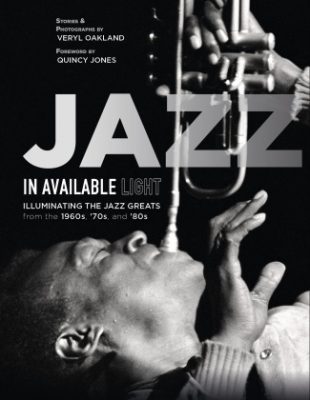

























I recently purchased Veryl Oakland’s photography book and it is truly amazing and inspiring. His photographs of Jazz artists are deeply personal and the accompanying essays contribute so much to the individual subjects of his camera. Jazz enthusiasts should buy this magnificent book before it goes out of print. Like the musicians whose images are captured here, it’s a masterpiece.